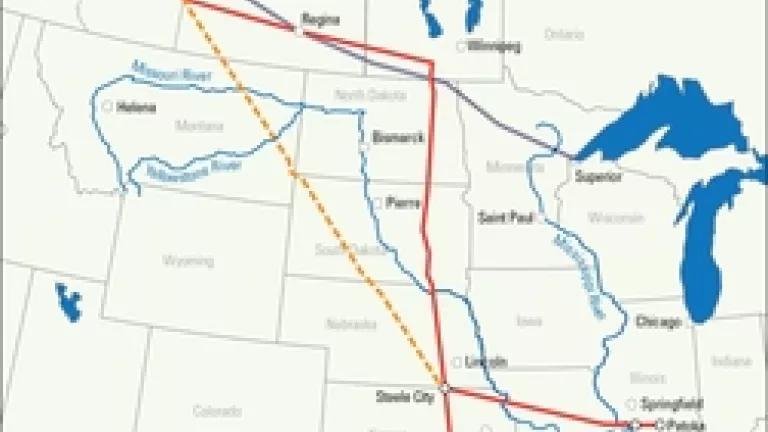
The oil industry call for fast-tracking new pipelines from the Midwest to the Gulf Coast will fast-track a rise in oil prices that is good for oil companies, but not so good for consumers. Although the White House rejected the presidential permit for the Keystone XL tar sands pipeline in January, pipeline backers have cited high U.S. gas prices as a reason to expedite pipeline approval. However, there is no credible evidence that gas prices would decline if Keystone XL were constructed. The truth is that the Keystone XL tar sands pipeline could actually add to our pain at the pump. We do not need the Keystone XL tar sands pipeline and the risks that it would bring to U.S. climate, lands and waters. Rising gas prices will not be solved by approving or expediting permits for any part of Keystone XL. The solutions lie in reducing our demand for oil, increasing fuel efficiency standards, and eliminating subsidies for the oil industry.
Here are five reasons why the Keystone XL tar sands pipeline will raise oil prices:
1. Keystone XL is a tar sands pipeline through the United States, not to it. The proposed Keystone XL tar sands pipeline, whether seen as a whole or as a northern and southern segment, would pump some of the world’s dirtiest oil that is strip-mined and drilled from under the boreal forests of Alberta, Canada, straight through the heart of America’s breadbasket to refineries on the Texas Gulf Coast. Keystone XL won’t bring additional oil into the United States for over a decade – it just diverts oil from the Midwest to the Gulf Coast where it can be refined and exported.
2. Gulf Coast refineries have become focused on exporting refined products internationally, where prices for diesel and gasoline are higher. Even as Americans pay more for gasoline, Gulf Coast refiners are converting their operations to produce diesel for international export rather than gasoline for domestic use. These refineries provide the U.S. market with less than half of the gasoline that they did just five years ago – and that’s because they’re now exporting over 2.5 million barrels a day of diesel and gasoline to international buyers.
3. Keystone XL would increase the price of oil in the Midwest – which produces gasoline for U.S. consumers. The Midwest now provides far more gasoline for American consumers than the Gulf Coast. The flow of Canadian crude to the Midwest has lowered oil prices there by more than $10 a barrel when compared by the Gulf Coast. This helps the U.S. consumers who buy those products refined in the Midwest. Keystone XL would reverse this by diverting oil from the Midwest to Texas. Midwestern supplies would tighten. Oil economists have predicted Keystone XL could significantly increase Midwest gas prices.
4. The foreign oil corporation that wants to build the pipeline has admitted that Keystone XL is intended to increase the price of heavy crude oil in the United States. “The resultant increase in the price of heavy crude is estimated to provide an increase in annual revenue to the Canadian producing industry of US $2 billion to US $3.9 billion,” TransCanada said.
5. The numbers tell the story: Shipping oil to the Gulf ships it out of the U.S., shipping to the Midwest keeps it in the U.S. Midwestern refineries are configured to produce gasoline because they continue to sell about 99 percent of their product to U.S. customers. In 2000, Texas Gulf Coast refineries produced more than twice as much gasoline as they did diesel. That’s changed. Today, Texas Gulf Coast refineries produce a ratio of roughly 40 percent gasoline to 60 percent diesel. The U.S. doesn’t use much diesel, but international markets do. And tar sands crude is especially well suited to turn into diesel. Meanwhile, Midwestern refineries focused on the American consumer refine a barrel of crude into 70 percent gasoline and 30 percent diesel.
The best way for Americans to lower their fuel costs is to help end the oil industry’s monopoly. With gas prices possibly going as high as $4 per gallon, that’s a substantial part of household income. More efficient cars could lower that figure dramatically. By 2030, American consumers could save $500 billion as a result of the new 54.5-miles-per-gallon fuel standard. In addition to more efficient cars, Americans can demand more transportation choices through increased investments in mass transit, and other ways to move more easily around our communities. And we even pay the oil industry – to the tune of at least $4 billion a year in tax breaks - just to let them charge us ever-increasing prices for gasoline. Congress should end subsidies to the oil industry.
It makes no sense to rubber-stamp or expedite fossil fuel projects like the Keystone XL tar sands pipeline. Keystone XL continues our oil addiction and benefits the oil industry at the expense of our pocketbooks, climate, homes and waters.
